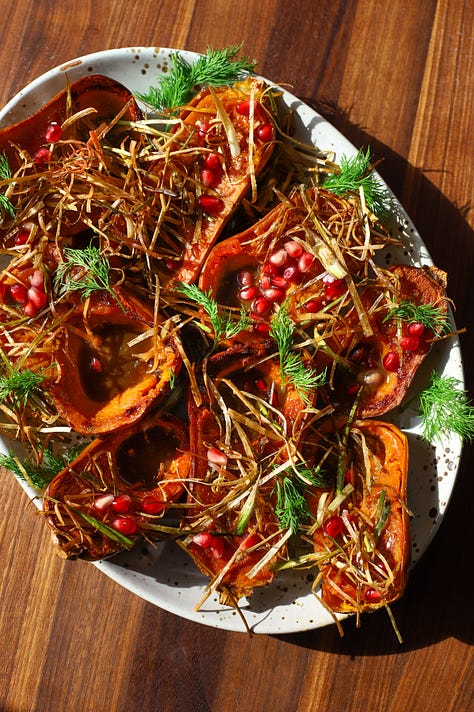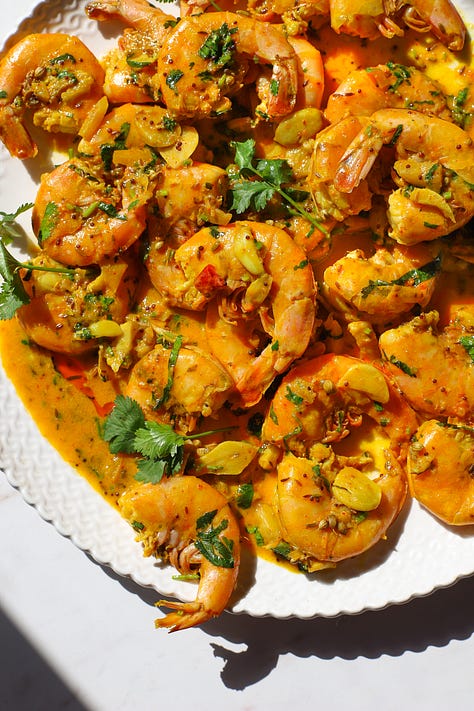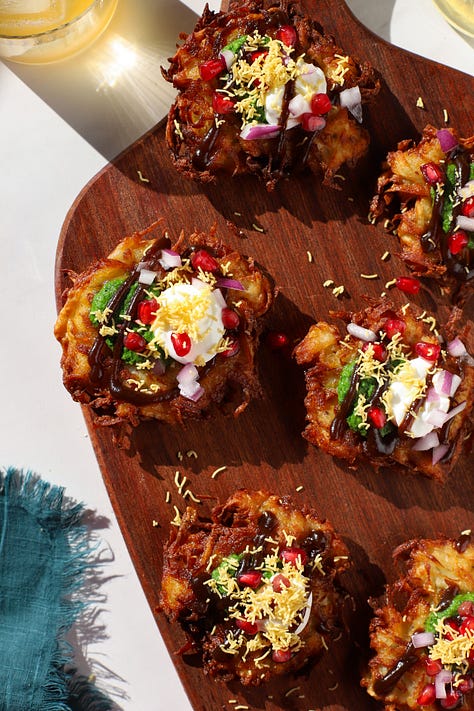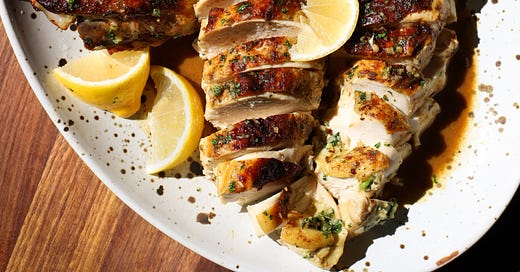Happy Diwali, readers! As a South Asian adoptee, I didn’t grow up celebrating Diwali at home, but my mom would take me to the local South Asian Cultural Center where there would be dancing, performances, and, of course, banquet tables laden with deliciousness — from aluminum trays of steaming biryani and fried things galore to platters of mithai and bowls of gulab jamun (both my mom and I’s favorite).
As an adult, it’s been such a joy creating my own Diwali traditions and foods. For this weekend’s centerpiece, I’m drawing inspiration from my travels last fall and the past winter for the Diaspora Cookbook. One of the things that I ate in my off-time and have been thinking about constantly since is murgh malai tikka—from a stall in Delhi, standing on the street in Mumbai, and sitting overlooking Lake Pichola in Udaipur—which is chicken flavored with a cream-based (malai meaning cream) marinade and cooked in a tandoor. Stateside, this milder tandoori chicken is harder to find since its bright red tandoori chicken tikka cousin reigns supreme in restaurants.
This roast chicken pulls inspiration from malai tikka, starting with a combination of heavy whipping cream and buttermilk instead of the more traditional yogurt. The mix of spices varies for this dish, but its more focused on aromatic and warming than savory and spicy. Here, green cardamom, fennel, and garam masala provide the backbone along with green chilies, cilantro, ginger, and garlic. Dried fenugreek leaves, or kasoori methi, round everything out with their sweet, herbal, maple-like flavor.
The result is the most succulent, juicy, full-flavored roast chicken. The lactic acid, calcium, and enzymes in both the buttermilk and cream slowly break down the chicken, tenderizing the meat. And, the sugars in the dairy, plus some butter basting, creates an epically beautiful burnished skin, rivaling any rotisserie chicken (I mean just look at the photo below!).
The beauty of classic murgh malai tikka is not only the nuanced marinade, but also the dreamy smokiness that the tandoor imparts. But, most of us don’t have tandoors at home, so I rely on the dhungar method while the chicken rests before carving. This method — popular in South and Southeast Asian cooking — relies on one piece of hardwood lump charcoal and ghee. The charcoal is heated until red hot and then put in a small metal bowl next to whatever you want to smoke. A spoonful of ghee is dolloped on the hot coal, creating lots of smoke, and then everything is wrapped up tightly for 10 to 15 minutes, imbuing the chicken with a gentle kiss of buttery smokiness. All of that being said, this methi malai roast chicken is absolutely delicious without this step, so it’s a very optional one! And, come summer, this chicken would be a great candidate for grilling.
Methi-Malai Roast Chicken
This chicken is the most flexible star of the show, working well with a variety of supporting cast members. Serve with jeera rice, a simple vegetable sabzi or kachumber (cucumber salad). Or, enjoy with steamed baby potatoes tossed with lots of salted butter and chopped tender green herbs, like chives, parsley, cilantro, or mint, and a green salad. It also makes an ideal mate for my fave carrot salad.
This marinade also works well with chicken legs. Keep the marinating time the same, and roast until the internal temperature reaches 180 to 185°F (the cooking time will range from 40 to 50 minutes). Generally, the internal temperature for chicken is 165°F, but that doesn’t take into account the different cuts of chicken. Because the thighs have more connective tissue and fat, they are actually the best, most tender, succulent versions of themselves at around 195°F internal temp, which they’ll reach when resting.
Serves 4 to 6
INGREDIENTS
One 3- to 4-pound whole chicken
5 garlic cloves
1 tablespoon finely chopped ginger
1 to 2 serrano peppers, roughly chopped
½ cup, plus 1 tablespoon, chopped cilantro, leaves and tender stems
¼ cup kasoori methi (dried fenugreek leaves), very lightly packed
1 tablespoon garam masala (I’m partial to the one from Diaspora Co.)
8 green cardamom pods
1 teaspoon fennel seeds
¼ teaspoon ground turmeric
1 tablespoon, plus ¼ teaspoon, Diamond Crystal or 1½ teaspoons, plus ⅛ teaspoon, Morton’s kosher salt
¼ teaspoon MSG (optional)
¾ cup buttermilk
2 tablespoons fresh lemon juice (from ½ to 1 lemon)
½ cup heavy whipping cream
3 tablespoons unsalted butter
1 golf ball-sized piece hardwood lump coal (optional)
1 teaspoon ghee (optional)
1 lemon, cut into wedges
METHOD
To spatchcock the chicken, place one 3- to 4-pound chicken breast side-down on a plastic cutting board and using kitchen shears, cut down one side of the backbone. Then, cut down the other side of the backbone to remove it, saving it for stock, if desired, or discarding it. Flip the chicken over and press down on the breasts with the palm of your hand to break the breast bone and flatten the chicken. Set aside.
To make the marinade, peel and roughly chop 3 garlic cloves and add them to a blender or food processor along with 1 tablespoon finely chopped ginger, 1 to 2 serrano peppers, depending on your desired heat level (if you want a milder heat, you can remove the ribs and seeds), ½ cup roughly chopped cilantro, ¼ cup very lightly packed kasoori methi, 1 tablespoon garam masala, 8 green cardamom pods, 1 teaspoon fennel seeds, ¼ teaspoon ground turmeric, 1 tablespoon Diamond Crystal or 1½ teaspoons Morton’s kosher salt, ¼ teaspoon MSG, if using, ¾ cup buttermilk, and 2 tablespoons fresh lemon juice. Blend, starting on low and increasing to high, until smooth, add ½ cup heavy whipping cream and pulse a few times to combine.
Place the spatchcocked chicken in a bowl or gallon zip-top bag, pour in marinade, making sure the chicken is fully coated. Cover or seal and refrigerate for at least 12 hours, up to 48 hours (24 to 48 hours is ideal), turning the chicken in the marinade halfway through to make sure it is evenly seasoned.
Remove the marinated chicken from the refrigerator 30 minutes to 1 hour before roasting to let it come to room temperature.
Meanwhile, preheat the oven to 425°F.
Remove the chicken from the marinade, letting most of the marinade drip off the chicken back into the bowl or bag, and place the chicken breast side-up on a rimmed sheet pan (this fits perfectly on a quarter sheet pan). Roast on the middle rack of the oven with the thighs facing the back of the oven. Melt 1 tablespoon unsalted butter in a small skillet or the microwave. After 20 minutes of roasting, baste the chicken with the melted butter and continue to roast, basting with the juices that have accumulated at the bottom of the pan every 5 to 10 minutes until the internal temperature of the thickest part of the breast reads 160°F and the chicken thighs are at least 180°F, 30 to 45 minutes more, depending on the size of the chicken. (The total cooking time will range from 50 to 65 minutes.)
Let the chicken rest at room temperature for 15 to 30 minutes (don’t worry, it’ll still be hot when you carve it!). If you want to do the optional dhungar method, this is the time. While the chicken is resting, melt the remaining 2 tablespoons unsalted butter in a small skillet over medium heat. Peel and finely chop the remaining 2 garlic cloves, add it to the melted butter, and cook, stirring occasionally, until the garlic softens and just starts to turn light golden. Turn off the heat, stir in the remaining 1 tablespoon chopped cilantro, and set aside.
OPTIONAL DHUNGAR METHOD: To ghee-smoke the chicken, heat 1 golf ball-sized piece hardwood lump coal over the flame on a gas stove until red hot, 6 to 12 minutes depending on the brand of coal. (I like to start this 5 to 10 minutes before the chicken is done roasting.) Prepare a piece of aluminum foil that will fit around the pan—you can place two pieces of foil together and fold them in the center to create a larger, airtight piece, if needed. When the chicken comes out of the oven place a metal katori or small metal bowl on in the corner of the pan (you can also create a little bowl out of aluminum foil) and place the red hot piece of coal in the bowl, spoon 1 teaspoon ghee on top of the coal—it will start smoking immediately!—and cover the whole pan with aluminum foil, sealing the edges around the pan to be as airtight as possible. Let sit for 15 minutes. Uncover and discard the coal and ghee.
To serve, carve the chicken—see below for a step-by-step breakdown—and arrange on a platter with 1 lemon, cut into wedges. Brush the chicken liberally with the garlic-butter mixture, spoon any pan juices over and around the chicken, and serve immediately.
First time carving a chicken? Let’s do it together. Using a boning knife, cut through the joint connecting the thigh to the body to remove the leg and then cut through the joint connecting the thigh and drumstick to separate the two. Repeat with the other leg. To remove the wings, pull the drumette up and cut through the joint connecting it to the breast. To remove the breasts, cut down one side of the breastbone, running your knife in shallow, long strokes against the ribcage and carefully cutting away from the wishbone. Repeat with the other breast, and then cut both breasts crosswise into ½-inch slices. Save the rest of the carcass for stock or discard.
Make-ahead: The chicken can be marinated up to 48 hours in advance (Don’t marinate it for longer than this because the lactic acid and enzymes in the dairy will start to denature the protein in the meat and it will be soft not succulent). The chicken is best served immediately after its roasted and rested. Any leftover chicken makes a great addition to salads, sandwiches, and wraps.
Can’t find kasoori methi?: This flavor is hard to replicate, but you can sub in ¼ cup chopped fresh mint leaves to round out the marinade.



There are so many delectable routes you can go when it comes to Diwali feasting. Last year, I started off with latke chaat and the perfect pakora and then served a steaming platter of chicken biryani, raita, tadka dal, green bean sabzi, and my buttermilk gulab jamun.
This year, the centerpiece of my table will be the above methi-malai roast chicken surrounded by seasonal vegetable sides and sweets, like roasted squash halves drizzled with tamarind dressing and topped with fried leeks and pomegranate arils, a big leafy salad tossed with roasty-toasty dressing, and a carrot-ginger cake swooshed with jaggery cream cheese frosting for dessert. Here are a few recipes to make your Diwali table bright and delicious:
Bites ‘n’ nibbles
Latke Chaat: A cheeky Diwali-Chanukah mashup of crispy potato-onion latkes topped with plain yogurt or sour cream, sweet ‘n’ tangy tamarind chutney, green chutney, red onion, pomegranate arils, and nylon sev.
The Perfect Pakora: A recipe that works with any vegetable. My favorite combination will forever be bitter melon and sweet red onions, but sweet potatoes and a mess of green onions and cilantro is my runner-up.
Samosas, Three Ways: Choose your own filling adventure with kheema, tandoori masala paneer, and classic potato and pea samosa.
Vegetable goodness
My Fave Carrot Salad: Simple, crisp, and zippy, this salad combines grated carrots with lots of tender green herbs, toasted fennel, coriander, and cumin, all dressed with olive oil and lemon juice.
Roasted Squash with Frizzled Leeks & Tamarind Dressing: This is one of those dishes that can be a side or double as a stunning vegetarian main. Custardy halves of honeynut squash are the perfect foil for luscious tamarind dressing, fried leeks, and pomegranate arils.
The main event
Hyderabadi-Style Chicken Biryani: Diaspora Co.’s Biryani Masala will forever be one of my favorite masalas. No need to measure out a bunch of individual spices, they are all in one tin for ya (16 spices total!).
Saag Paneer Galette: Flaky crust surrounding highly spiced greens, dollops of farmer’s cheese, and topped with a chili tadka—need I say more?
Achari Shrimp Scampi: Lemon pickle and South Asian pickling spices—coriander, cumin, black mustard, and fennel—lots of garlic, white wine, and butter make a damn lick-you-plate-able sauce for shell-on shrimp.
Something sweet
Buttermilk Gulab Jamun: These are the best gulab jamun. PERIOD. Traditionally made with milk powder, these are made with a combination of milk and buttermilk powders, which balance the sweetness of the dish.
Carrot-Ginger Snacking Cake: This cake is even better the day after its baked and served straight from the fridge, making it an ideal make-ahead dessert.







Swooooooon!
Made this tonight and it was absolutely delicious. Best Indian roast chicken I’ve ever made (and I have tried SO many recipes). Would be amazing on a thanksgiving turkey!